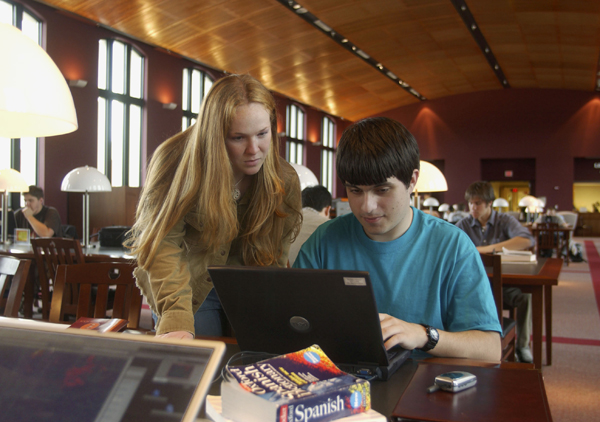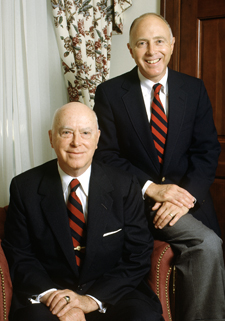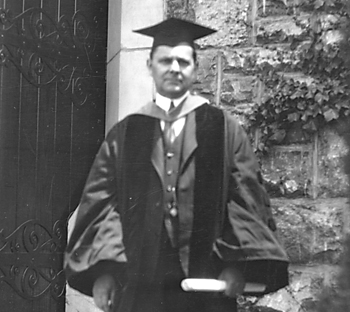 The history of campaigns at Virginia Tech The history of campaigns at Virginia Tech
by Jen Henderson and Alexandria Marder
Imagine that it's 1922 and that for more than three years, your university has been trying to raise money for a building on campus to memorialize fallen soldiers and provide additional amenities for alumni and friends. Now imagine standing in front of a crowd of your fellow alumni, imploring them to help makethis building a reality. Finally, imagine that, after your powerful speech, you have single-handedly raised $72,742--in just 17 minutes.
|
|
| A legendary fundraiser, Lawrence Priddy (Class of 1897) was an energetic personality. He built a national reputation as an insurance broker, eventually serving as president of the National Association of Life Underwriters. He also used his persuasive skills to aid his alma mater. Priddy's first fundraising feat was an organized effort, soon after his graduation, to raise money for a YMCA building on Tech's campus. Priddy traveled around the country soliciting donations--and securing them. One story says that he visited a wealthy philanthropist in New York and was turned away at the door by his butler. Unfazed, Priddy returned the next day in a rented tuxedo and left with a sizable gift. Priddy's persistence paid off for Virginia Tech again in 1922 when, in 17 minutes, he raised $72,742 to build the War Memorial Gymnasium, today's War Memorial Hall. |
|
|
For one man, Lawrence W. Priddy (Class of 1897), this accomplishment was not an exercise of the imagination. Priddy spoke to a group of alumni gathered on campus for a 50th Jubilee celebration and raised the funds--an amount thattoday would be worth nearly $800,000--to build what is now War Memorial Hall. This legendary feat is a major achievement of the campaign begun by VPI President Julian Ashby Burruss (Class of 1898) in 1919 to develop the infrastructure of the university campus. But it's also a significant moment in the history of campaigns at Virginia Tech. Today's War Memorial Hall is emblematic both of earlier campaign goals to raise money for the university's physical structures and the generosity that has shaped Virginia Tech into the leadingcomprehensive university it is today.
While the goals of campaigns have shifted over the years, accommodating both the buildings themselves and what happens inside them, the history of campaigns at Virginia Tech shares a common foundation: a desire by friends and alumni to see the university succeed.
Even as early as 1872--Virginia Agricultural and Mechanical College's inaugural year--this common desire was evident. That year, several people donated 501 books to start the first library, and local farmers donated equipment, seed, animals, and other amenities to create the first college farm. While the majority of support for facilities and educational programming came from the state budget, these in-kind gifts helped to transform the fledgling university.
In the 1980s, a downturn in government funding necessitated a greater reliance on private gifts. President William E. Lavery hired the first vice president for development, Charles M. Forbes (engineering '49), who in 1983 launched Virginia Tech's capital campaign, The Campaign for Excellence.
In just three years, the campaign had raised more than double its goal of $50 million, bringing $118 million to the university. In addition to benefiting from several large private gifts that enhanced the quality of education on campus, the campaign bolstered the assets of the Virginia Tech Foundation, which grew in value from $7.4 million to $123.4 million. This increase established a more secure financial future for the university through revenue generated by the endowment. The campaign also signaled a shift in the importance of private giving. Although government funding remained an essential element of the university's success, that funding was significantly augmented by the generosity of friends and alumni.
In 1995, President Paul E. Torgersen announced the launch of a second capital campaign, The Campaign for Virginia Tech: Making a World of Difference, with a goal of $250 million dollars. Because of the generosity of nearly 71,000 individuals, the campaign increased the payout for scholarships and fellowships by more than $2 million annually and raised the value of the university's general endowment by more than 124 percent. In the end, the campaign raised more than $337 million.
During both The Campaign for Excellence and The Campaign for Virginia Tech: Making a World of Difference, philanthropy provided, in part, a means for the university to grow--both in size and in scope. Today, the purpose of a campaign has broadened still, and on Oct. 20, 2007, Virginia Tech launched its most ambitious campaign to date, The Campaign for Virginia Tech: Invent the Future.
Unlike the goal met by that historic gathering of alumni in 1922, today's funding priorities no longer focus solely on the infrastructure of the university. And in contrast to the previous two campaigns, this one comes at a time when private philanthropy is the key component in our drive toward excellence. Today, thanks to our supporters, we have more programs, more students, and more success stories in research and education than ever before. Private philanthropy gives everyone the opportunity to participate in these successes and to help shape the future of our society.
|
 |
|
A bridge to the future | One of the highlights of Virginia Tech's second capital campaign, Making a World of Difference, was an anonymous gift to erect what is now known as Torgersen Hall, the most technologically advanced building on campus.
Architecturally striking, Torgersen Hall includes a bridge (pictured at left) that joins to Newman Library, a link between the university's traditional academic resources and its advancing technology.
The bridge's soaring arch across the university mall honors the generosity of our donors and exemplifies Virginia Tech's commitment to academic excellence, technological leadership, and, of course, Ut Prosim.
|
|
|
|
|
|
|
|
|
 |
|
A transformative gift | Virginia Tech launched its first official capital campaign in 1983. One of the largest and most influential gifts during that campaign came from Robert B. Pamplin (business administration '33) and his son, Robert B. Pamplin Jr. (business administration '64). In 1986, the two men gave a $10 million gift to the College of Business that led to naming it the Pamplin College of Business. The Pamplins have made additional gifts and pledges, which now total more than $26 million. The Pamplin Endowment has supported scholarships and professorships and provided general operating support. |
|
|
|
Funding the future of the University Libraries
|
|
 |
|
|
For centuries, libraries have been repositories of knowledge. When Egypt's King Ptolemy II built the Great Library of Alexandria, his goal was to obtain a copy of every scroll ever written. Though libraries today rarely store scrolls, they still have a mission to amass written resources to benefit their users--whether those resources take print or electronic form. University Libraries at Virginia Tech is no different.
Despite the evolving role of libraries in the modern academic environment, our libraries must still provide scholarly resources to students and faculty and staff members. As a result, the libraries are an integral part of The Campaign for Virginia Tech: Invent the Future.
|
|
|
|
|
Because the partnership between the university's library system and its colleges is the foundation of the academic enterprise, each of Virginia Tech's eight colleges will raise funds to support the University Libraries. Every gift to a college in support of the libraries helps both entities.
In many disciplines, information changes at such a rapid pace that scholars will be left behind if they do not have access to the most up-to-date knowledge. To give students and faculty and staff members that access, each college has created a wish list of books, journals, and other resources. Funds raised during the campaign will be used to purchase these resources.
Dean of Libraries Eileen Hitchingham notes, "Sometimes people think they can find everything for free on the Internet, but that's not true. Our students and faculty members won't have access to 'the good stuff' they need unless the library buys it or subscribes to it electronically. With books costing hundreds of dollars each and many journal subscriptions costing thousands per year, library support is essential," she adds. "The library needs to offer the kinds of materials that will support more award-winning student projects, help faculty members publish more than 100 books each year, and give all of our students the opportunity to excel in their fields."
The resources in our libraries make possible the education, research, and outreach that embody the university's mission. Funds raised by the colleges will allow the University Libraries to continue providing Virginia Tech with the resources it needs to invent the future.
|
|
 Jen Henderson and Alexandria Marder formerly wrote for the Office of University Development. Jen Henderson and Alexandria Marder formerly wrote for the Office of University Development.
|




